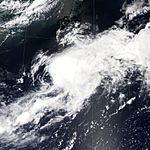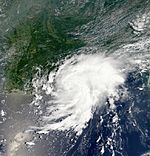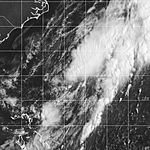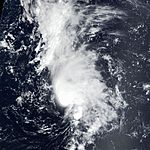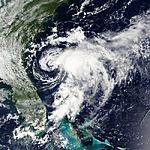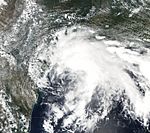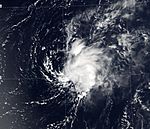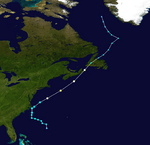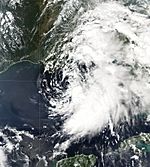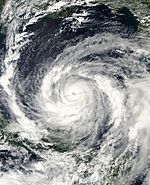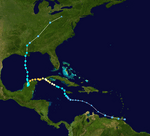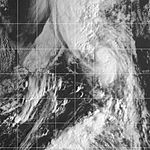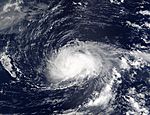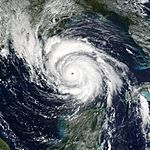Quick facts for kids
2002 Atlantic hurricane season
 |
| First storm started: |
July 14, 2002 |
| Last storm ended: |
October 16, 2002 |
| Strongest storm: |
Hurricane Lili - 938 mbar, 145 mph winds |
| Total storms: |
12 |
| Hurricanes: |
4 |
| Major hurricanes (Cat. 3+) |
2 |
| Cost of damage: |
$1.2 billion (2002 USD)
$1.35 billion (2006 USD) |
| People killed: |
23 direct |
|
The 2002 Atlantic hurricane season was a period when many hurricanes and tropical storms formed in the Atlantic Ocean. This season officially started on June 1 and ended on November 30. During this time, 12 named storms and 4 other hurricanes developed.
Because of an El Niño event in the Pacific Ocean, the season ended earlier than usual, on October 16. Even though most of the season was quiet, September was very busy. It even broke the record for the most storms forming in September. The most important storms were Hurricane Lili, which was the strongest and caused the most deaths, and Hurricane Isidore, which caused 7 deaths in Louisiana.
Storms of 2002: A Closer Look
This section describes the different tropical storms and hurricanes that formed during the 2002 Atlantic hurricane season.
Tropical Storm Arthur: The First Storm
| Tropical storm (SSHS) |
|
|
| Duration |
July 14 – July 16 |
| Intensity |
60 mph (95 km/h) (1-min), 997 mbar (hPa) |
Tropical Depression One formed off the coast of North Carolina on July 14. It quickly grew into Tropical Storm Arthur. Arthur moved northeast across the Atlantic. It then turned north and started to weaken. Before completely dying on July 16, Arthur made landfall in Newfoundland, Canada.
Tropical Storm Bertha: Double Landfall
| Tropical storm (SSHS) |
|
|
| Duration |
August 4 – August 9 |
| Intensity |
40 mph (65 km/h) (1-min), 1007 mbar (hPa) |
Bertha quickly formed into a tropical storm from a tropical depression on August 4. Just two hours later, it made landfall in Boothville, Louisiana. Over Louisiana, it weakened back to a tropical depression. Bertha moved back into the Gulf of Mexico but did not become a tropical storm again. On September 9, Bertha made landfall a second time near Kingsville, Texas. It died out only ten hours later. Bertha caused about $200,000 in damage and led to 1 death.
Tropical Storm Cristobal: Ocean Wanderer
| Tropical storm (SSHS) |
|
|
| Duration |
August 5 – August 8 |
| Intensity |
50 mph (85 km/h) (1-min), 999 mbar (hPa) |
Tropical Storm Cristobal formed in August 2002. It mostly stayed away from land during its short life. However, after it weakened, its leftover moisture caused rain and wind on Bermuda. It also created rough seas that led to three people drowning near Long Island. Luckily, no major damage was reported from Cristobal.
Tropical Storm Dolly: No Land Impact
| Tropical storm (SSHS) |
|
|
| Duration |
August 29 – September 4 |
| Intensity |
60 mph (95 km/h) (1-min), 997 mbar (hPa) |
Tropical Storm Dolly formed on August 29 as Tropical Depression Four. It became Tropical Storm Dolly before it died out on September 4. Tropical Storm Dolly did not affect any land areas during its entire existence.
Tropical Storm Edouard: Florida Landfall
| Tropical storm (SSHS) |
|
|
| Duration |
September 1 – September 6 |
| Intensity |
65 mph (100 km/h) (1-min), 1002 mbar (hPa) |
Edouard formed on September 1 as Tropical Depression Five. It then became a tropical storm. Edouard made a loop in the ocean and weakened. On September 5, it made landfall in Ormond Beach, Florida, as a very weak tropical storm. Edouard died after crossing Florida. The amount of damage it caused is unknown, and no one was killed by Edouard.
Tropical Storm Fay: Texas and Mexico
| Tropical storm (SSHS) |
|
|
| Duration |
September 5 – September 11 |
| Intensity |
60 mph (95 km/h) (1-min), 998 mbar (hPa) |
On September 5, Tropical Depression Six formed. It moved slowly and became Tropical Storm Fay the next day. On September 7, Fay made landfall near Port O'Connor, Texas. Fay then moved over Texas and into Mexico. It did not completely die out until September 11.
Tropical Depression Seven: Short-Lived Storm
| Tropical depression (SSHS) |
|
|
| Duration |
September 7 – September 8 |
| Intensity |
35 mph (55 km/h) (1-min), 1013 mbar (hPa) |
Tropical Depression Seven formed from a tropical wave on September 7. It had a top wind speed of 35 miles per hour (mph) and a lowest pressure of 1013 mbar. It generally moved west. Strong winds in the upper atmosphere, called wind shear, broke it apart on September 8. It did not affect any land areas.
Hurricane Gustav: Late Hurricane
| Category 2 hurricane (SSHS) |
|
|
| Duration |
September 8 – September 12 |
| Intensity |
100 mph (155 km/h) (1-min), 960 mbar (hPa) |
On September 8, Subtropical Depression Eight formed. It then became a subtropical storm and was named Gustav. After that, Gustav changed into a tropical storm. Tropical Storm Gustav passed very close to Cape Hatteras, North Carolina. Gustav then moved away and became a hurricane on September 11. It moved very fast and made landfall over Nova Scotia and Newfoundland in Canada before it died on September 12. Since Gustav became a hurricane on September 11, it was the latest day ever for a tropical storm to become a hurricane in the Atlantic. Gustav caused 4 deaths and about $340,000 in damage.
Tropical Storm Hanna: Gulf Coast Impact
| Tropical storm (SSHS) |
|
|
| Duration |
September 12 – September 15 |
| Intensity |
55 mph (90 km/h) (1-min), 1001 mbar (hPa) |
Tropical Storm Hanna formed as Tropical Depression Nine. It quickly became Tropical Storm Hanna before making landfall near the border of Mississippi and Alabama on September 14. Hanna caused about $20 million in damage and led to 3 deaths.
Hurricane Isidore: A Powerful Storm
| Category 3 hurricane (SSHS) |
|
|
| Duration |
September 14 – September 27 |
| Intensity |
125 mph (205 km/h) (1-min), 934 mbar (hPa) |
Isidore started as Tropical Depression Ten on September 14. It crossed Venezuela soon after forming. Because it stayed over and near Venezuela, it weakened and was no longer a tropical depression. However, its remains reformed into Tropical Depression Ten again on September 17. The next day, it became Tropical Storm Isidore. Isidore later became a hurricane and moved slowly over Cuba and the Yucatán Peninsula in Mexico. The storm made landfall in Louisiana as a tropical storm on September 26. Isidore then weakened again and was last seen on September 27 before it moved into a cold front in Pennsylvania. Isidore caused about $1.3 billion in damage and led to 22 deaths. The damage in Cuba is not known.
Tropical Storm Josephine: Quick to Form, Quick to Fade
| Tropical storm (SSHS) |
|
|
| Duration |
September 17 – September 19 |
| Intensity |
40 mph (65 km/h) (1-min), 1009 mbar (hPa) |
Tropical Storm Josephine was a weak tropical storm that formed on September 17 as Tropical Depression Eleven. It became a tropical storm later that day. It died out only two days later, on September 19. Josephine did not cause any damage or deaths.
Hurricane Kyle: Long-Lasting Storm
| Category 1 hurricane (SSHS) |
|
|
| Duration |
September 20 – October 12 |
| Intensity |
85 mph (140 km/h) (1-min), 980 mbar (hPa) |
Hurricane Kyle lasted for more than three weeks! It started as a Subtropical Depression on September 20. It then became a subtropical storm, then a tropical storm, and after that, a hurricane. It weakened back to a tropical storm and then to a tropical depression. It became a tropical storm again and made landfall in McClellanville, South Carolina. Kyle made its second and final landfall in Long Beach, North Carolina, on the same day. Kyle caused about $5 million in damage and led to 1 death.
Hurricane Lili: The Strongest Storm
| Category 4 hurricane (SSHS) |
|
|
| Duration |
September 21 – October 4 |
| Intensity |
145 mph (230 km/h) (1-min), 938 mbar (hPa) |
Hurricane Lili formed on September 21 as Tropical Depression Thirteen. It became a tropical storm on September 23. It then weakened into a tropical wave and was no longer a tropical storm. However, it reformed and became a tropical depression again on September 28. Lili became a tropical storm again and then a hurricane on September 30. Lili later made landfall in Cuba and Louisiana. Lili caused almost $1 billion in damage and led to 15 deaths.
Tropical Depression Fourteen: The Last Storm
| Tropical depression (SSHS) |
|
|
| Duration |
October 14 – October 16 |
| Intensity |
35 mph (55 km/h) (1-min), 1002 mbar (hPa) |
Tropical Depression Fourteen formed from a tropical wave on October 14. It had maximum wind speeds of 35 mph and a lowest pressure of 1002 mbar. For most of its life, experts thought it would become a tropical storm and move through The Bahamas. However, strong wind shear from the northeast stopped it from growing stronger. After making landfall in southern Cuba on October 16, a cold front destroyed it. Even though it brought heavy rains, it caused no damage.
Storm Names of 2002
This is a list of names that were planned for storms in the Atlantic during 2002. Names that were not used are marked with gray.
- Arthur
- Bertha
- Cristobal
- Dolly
- Edouard
- Fay
- Gustav
|
- Hanna
- Isidore
- Josephine
- Kyle
- Lili
- Marco (unused)
- Nana (unused)
|
- Omar (unused)
- Paloma (unused)
- Rene (unused)
- Sally (unused)
- Teddy (unused)
- Vicky (unused)
- Wilfred (unused)
|
Retired Storm Names
After the 2002 season, the names Isidore and Lili were "retired." This means they will not be used again for Atlantic hurricanes because of the severe damage and deaths they caused. In 2008, the names Ike and Laura were used instead for new storms.
Related pages
|
Tropical cyclones of the 2002 Atlantic hurricane season
|
|
|
|
|
|
Images for kids
See also
 In Spanish: Temporada de huracanes en el Atlántico de 2002 para niños
In Spanish: Temporada de huracanes en el Atlántico de 2002 para niños

 In Spanish: Temporada de huracanes en el Atlántico de 2002 para niños
In Spanish: Temporada de huracanes en el Atlántico de 2002 para niños

